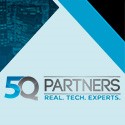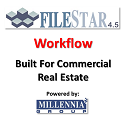Technology Leaders in The Age of Acceleration: Chandra Dhandapani, CBRE
Chandra Dhandapani is Chief Digital & Technology Officer at CBRE, the world’s largest commercial real estate services and investment firm. The company has more than 80,000 employees and serves real estate investors and occupiers through more than 450 offices worldwide. Chandra has responsibility for all aspects of the company’s digital strategy, technology infrastructure and digital enablement, from core infrastructure and information security to innovative product development. Prior to joining CBRE, she was a senior digital transformation leader and technology executive at Capital One Financial for 17 years.
What major technology projects were you involved with last year?
In partnership with our Head of Strategy, I led a comprehensive strategy exercise across our lines of business and our three regions, Americas, EMEA and APAC on potential risks and opportunities due to digital innovation. We concluded that for CBRE, digitally enabled opportunities significantly exceed disruption risk. This resulted in identification of distinct priorities for digital enablement across the board that we are now executing on.
The most exciting project for us in 2017 was creation of the CBRE 360 platform to digitize user experiences in offices and the multi-tenant facilities we manage. This idea emerged internally in response to a client RFI and we prototyped it through a 3-day hackathon (we called it a ‘protothon’), that led to winning the client account and has emerged into a scalable, plug and play platform. This resulted in CBRE launching a new business capability that combines this Software as a Service platform with our facilities/property management services.
The name CBRE 360 was chosen for the software platform as a natural evolution of our Workplace 360 program, where 3-4 years ago we pioneered reimagining the office space of the future with free addressing workspace. Today, in addition to the physical space, we are able to provide a mobile app powered by a plug and play platform that enables CBRE to provide custom experiences for individual occupier clients. For large campus clients, services may include wayfinding, conference room booking, finding and connecting with colleagues, ability to raise service requests, etc., all from the convenience of a mobile app. It is a collection of software driven capabilities at your fingertips. We also have a version for investor clients who want to provide great digital experiences in their multi-tenant buildings including access to food services, and a host of other amenities within the building.
We have a very active pipeline of clients interested in getting the app in the hands of their employees and/or tenants in a campus setting and/or across their portfolio of buildings.
What are your highest priority technology initiatives in 2018 and what are the drivers behind those initiatives?
A few that I can share are accelerated public cloud migration, which is driven by the need for innovation agility, and execution of digital strategy priorities resulting in new product/service offerings. We have adopted a multi-cloud strategy which allows us to leverage the rapid pace of innovation at public cloud providers. Any net new software, such as CBRE 360, is built and deployed on the public cloud. We are also actively migrating on-premise applications to the public cloud. We have a very talented cloud transformation team that just completed migrating 50 apps in 50 days.
 We now have agile product development teams in key hubs around the world. This allows us to behave like several startups within CBRE anywhere in the world. The mantra we use internally and increasingly is ‘globally connected, locally empowered’. We are being disciplined about building reusable components; building software that is appealing and relevant to a local market and can be leveraged in other markets with similar needs.
We now have agile product development teams in key hubs around the world. This allows us to behave like several startups within CBRE anywhere in the world. The mantra we use internally and increasingly is ‘globally connected, locally empowered’. We are being disciplined about building reusable components; building software that is appealing and relevant to a local market and can be leveraged in other markets with similar needs.
Another example of a new product we launched just a few weeks ago is Spacer. It’s a mobile tool that helps clients define their next workplace, including type of space and how much space they would need, and it’s integrated with Floored Plans, our proprietary space visualization product. Clients can start by filling out the Spacer quiz, which includes a few simple questions about the kind of space they are looking for and how many employees they have. They can then view 2D and 3D interactive floor plans based on their specific space program results. From idea to launch, Spacer took us less than six months. This would not have been possible without the domain expertise in CBRE and the ability to work with our talented technology teams in a rapid, iterative fashion. We have people with 20 plus years of experience in this industry. We’re marrying that experience with talented software engineers and product designers and embedding technology capabilities into the heart of how we serve our clients. It’s quite a differentiator.
What trends do you see having the most impact on the industry over the next three years and why?
In the immediate term, I would say increased flexibility through ‘space as a service’, infusing the power of machine learning into CRE workflows, increased near real-time visibility and intelligence into facilities/property management, and an intense focus on user experiences in commercial real estate – increasingly referred to as ‘consumerization’ of commercial real estate.
This Week’s Sponsor
Read Next
 5/15/2025
5/15/2025
Tech, Talent and Transformation: 2025 Digie Finalists Announced For 27 years, Realcomm has presented the Digie Awards to acknowledge companies, real estate projects, technologies, and individuals that have advanced the commercial real estate industry through the strategic use of technology, automation, and innovation.
 5/15/2025
5/15/2025
Empowering Space Management with Data-Driven Visualization For effective CRE space management, it’s critical to centralize lease data, maximize rental square footage (RSF), improve energy efficiency and reconfigure spaces to meet changing needs.
 5/8/2025
5/8/2025
The AI-Powered Workplace Evolution: Redefining the Business Landscape In today's rapidly evolving business environment, the fusion of Artificial Intelligence (AI) and Workplace Management is revolutionizing the way organizations approach workspace optimization and operational efficiency.
 3/27/2025
3/27/2025
The Convergence of Edge Computing, Cloud, and AI in Building Automation and Smart Buildings In the built environment, we have seen the convergence of Operational Technology (OT) and Information Technology (IT), later expanding to include Workplace Technologies (WP).


%20(1)%20(1)%20(1).png)









